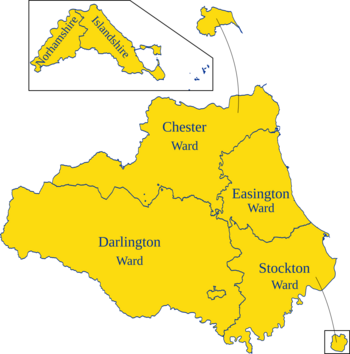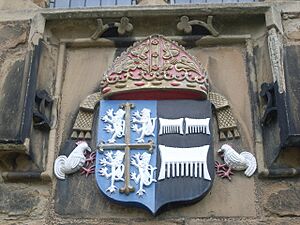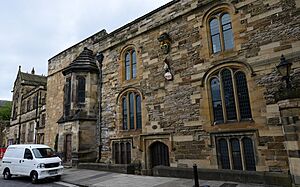County Palatine of Durham facts for kids
Quick facts for kids
County Palatine of Durham and Sadberge
|
|||||||||
|---|---|---|---|---|---|---|---|---|---|
| 883–1836 | |||||||||

The wards and exclaves of the palatinate. Bedlingtonshire was part of Chester-le-Street Ward, and Craikshire was part of Darlington Ward.
|
|||||||||
| Status | Prince-Bishopric | ||||||||
| Capital | Durham | ||||||||
| History | |||||||||
|
• Community of St Cuthbert established
|
684 | ||||||||
|
• Move to Chester-le-Street; Lands granted south of Tyne
|
883 | ||||||||
|
• Move to Durham
|
995 | ||||||||
|
• Bishops' palatine powers recognised
|
1293 | ||||||||
|
• The Act of Resumption curtails civil and judicial independence in the palatinate
|
1537 | ||||||||
|
• Durham returns its first members to Parliament
|
1654 | ||||||||
|
• Tenures Abolition Act ends the bishop's rights as chief feudal lord in the Palatinate
|
1660 | ||||||||
|
• County Palatine formally dissolved
|
1836 | ||||||||
|
|||||||||
The County Palatine of Durham was a special area in the North of England. Here, the bishop of Durham had powers usually held only by the king or queen. It grew from an older area called the Liberty of Durham, which started in the Anglo-Saxon times.
Over time, the bishops gained more and more power. By the late 1200s, Durham was known as a palatinate. This meant it had its own government and courts, much like a mini-kingdom within England. From the 1500s, the bishops' special powers slowly decreased. These powers were finally removed in 1836. The very last special court, called the court of chancery, closed in 1972.
The palatinate covered most of what is now County Durham. It also included parts of Tyne and Wear south of the Tyne. It even had small areas, called exclaves, in Northumberland and North Yorkshire. These included places like Lindisfarne, Bedlington, Norham, and Crayke.
Contents
History of Durham's Special Status
How Durham's Power Began
The County Palatine of Durham grew from an area known as the "Liberty of Durham." This area was also called "The lands of St. Cuthbert" or "The Liberty of Haliwerfolc." "Haliwerfolc" means "district of the holy saint's folk." St Cuthbert was a very important saint. People believed he strongly protected his land.
The story of this special area goes back to 684. King Ecgfrith of Northumbria gave a large piece of land to St. Cuthbert. This happened after St. Cuthbert became the Bishop of Lindisfarne.
Later, Viking invasions broke up the Kingdom of Northumbria. The Community of St. Cuthbert became very powerful. They gained control of a large area between the rivers Tyne and Tees. This land was known as the Patrimony of St. Cuthbert. Bishop Ecgred helped expand this land between 830 and 845.
Around 883, the church leaders moved from Lindisfarne to Chester-le-Street. Guthred, the Viking King of Northumbria, helped with this move. He gave the Community of St. Cuthbert the land between the Tyne and Wear rivers. This area became a buffer zone between different kingdoms. In 995, the church leaders moved again, this time to Durham. They received even more land then.
Becoming a County Palatine
The Liberty of St. Cuthbert's Land was almost independent from the Kingdom of England. Most of the area north of the Tees was not part of England's usual system of shires (counties). Also, the famous Domesday Book did not record these lands. They were not taxed by the king.
When William the Conqueror became King of England in 1066, he needed to control Northumbria. This was important to protect his kingdom from Scotland. In 1075, William allowed Bishop Walcher to buy the earldom of Northumbria. This might have been the start of the bishops' special powers. The Bishop of Durham seemed to take on the powers of an earl.
After the Norman Conquest, the shire system spread north. The county of Northumberland was formed. It included the Liberty of Durham. At first, Durham was seen as part of Northumberland. But the bishops of Durham disagreed with the power of Northumberland's sheriff (a local official).
These disagreements lasted until 1293. Bishop Antony Bek argued that Durham had always been independent. He said the sheriff of Northumberland had no power in Durham. His arguments were accepted. By the 1300s, Durham was officially a County Palatine. This meant it received royal orders directly, like a separate county. The bishops' power grew even more when Bishop Hugh de Puiset bought the area of Sadberge in 1189.
Losing Special Powers

Over time, the king and Parliament slowly reduced the bishops' powers. They wanted to make Durham part of England's regular government system. This process started in 1536. An act of Parliament took away the bishop's power to pardon crimes. It also said that Durham's legal system would now run in the king's name, not the bishop's.
In 1553, the diocese (the bishop's church area) was briefly ended. Bishop Cuthbert Tunstall was removed from his job. This happened because he did not agree with the religious changes of King Edward VI. But Queen Mary I brought back both the diocese and Bishop Tunstall in 1554.
In 1646, during the Commonwealth of England, the palatinate was again abolished. But it was brought back after the king returned to power. In 1654, Durham sent its first members to the Parliament of England. Before this, the bishops had strongly opposed Durham having representatives in Parliament.
By 1831, the county covered a large area and had many people living there. The special boundaries were used for Parliament until 1832. They were used for legal and local government until 1844. That year, most of Durham's small separate areas (exclaves) were joined with their surrounding counties.
In the 1800s, more laws were passed that changed Durham's government. The Durham (County Palatine) Act 1836 officially ended the palatinate. It gave the bishop's remaining special powers to the Crown. Durham was included in the new local government system for England and Wales in 1888. This created the Durham County Council. Durham kept its own special court system until 1971. That's when its separate court of chancery was finally closed.
How Durham was Governed
At its largest, the County Palatine had a big main area around Durham. It also had several smaller areas (exclaves) to the north and south. The main area was bordered by rivers, the North Sea, and the Pennines mountains.
The exclaves were:
- Bedlingtonshire, Islandshire, and Norhamshire in Northumberland.
- Craikshire in North Yorkshire.
Durham itself was divided into four "wards" by the 1200s. These were like smaller districts. They were named after their main towns: Chester-le-Street, Darlington, Easington, and Stockton. Each ward had its own official and a court that met every three weeks.
The Prior of Durham (a church leader) was the most important person after the bishop. He had his own court and special power over his people. There were also ten important families, called palatinate barons, in the 1100s. These included the Hyltons, Bulmers, Conyers, Hansards, and Lumleys. The Neville family also owned large lands in the county.
Taxes in Durham
It seems that the King did not tax Durham as early as 685. This was when St. Cuthbert became bishop of Lindisfarne. Later bishops gained large lands that were free from royal taxes. They also had their own courts, which meant the king's officials could not interfere. There is no sign that the bishops paid the "danegeld," an old tax. Durham was also left out of the Domesday survey, which was used for taxes.
Several old papers show Durham's freedom from taxes. These include documents from the reigns of King William II and King Henry II. They show that the palatinate was free from many taxes. They also confirmed special rights given by earlier kings. When the bishop's position was empty, the king's tax records (pipe rolls) show that Durham did not pay taxes like "carucage."
When King Henry II enforced a law called the Assize of Clarendon in Durham, he said it should not be used as an example for the future. This suggests that keeping the king's judges out was a special right of the palatinate.
St Cuthbert and the Haliwerfolc
During the Middle Ages, St Cuthbert became very important. He helped define the identity of the people living in this special, almost independent, region. In this area, the saint became a strong symbol of the freedom the region had. The people of the Palatinate were known as the "haliwerfolc." This Old English phrase means "people of the saint." St. Cuthbert was seen as fiercely protecting his land.
One example of Cuthbert's importance is the Battle of Neville's Cross in 1346. The leader of Durham Cathedral had a vision of Cuthbert. The saint told him to take a special cloth of the saint and raise it like a flag near the battlefield. When the leader and his monks did this, they felt protected "by the help of holy St Cuthbert."
Symeon of Durham told a story about a tax collector named Ranulf. King William the Conqueror sent Ranulf to make the people of the saint pay taxes. St. Cuthbert, angry about this, "horribly visited" Ranulf. Ranulf was happy to escape alive from the bishop's land. This story, even if it's not entirely true, shows how people believed the bishop had special rights about taxes.
Legacy of the Palatinate
Several buildings linked to the bishops of Durham and the palatinate still exist today. These include the castles at Durham, Norham, and Bishop Auckland. The old exchequer building on Palace Green in Durham also survives.
The County Palatine has been used to promote tourism in Durham. You might see the phrase "land of the prince bishops" on road signs when you enter County Durham.
Images for kids
-
Norham Castle, in Norhamshire, was built by Bishop Flambard in 1121. It was the bishops' main fort near the Scottish border.
-
Lindisfarne Priory, in Islandshire. This island was where the diocese's first cathedral was. It was also the original burial place of St Cuthbert.







